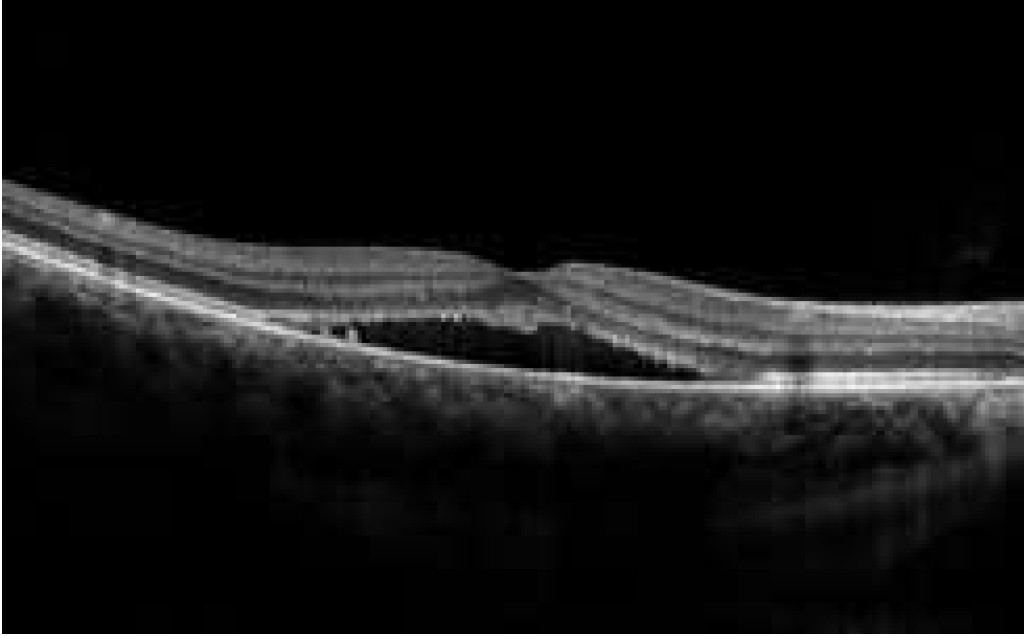What is central serous chorioretinopathy?
Central serous chorioretinopathy is when fluid builds up under the retina. This can distort vision. The fluid leakage comes from a layer of tissue under the retina,called the choroid. There is another layer of cells called the retinal pigment epithelium (RPE). When the RPE doesn’t work as it should, fluid builds up under the RPE. As a result,a small detachment forms under the retina,causing vision to become distorted.
Central serous chorioretinopathy usually affects just one eye at a time, but both eyes can be affected at the same time.
What are central serous chorioretinopathy symptoms?
Symptoms of central serous chorioretinopathy can include:
- distorted, dimmed, or blurred central vision
- a dark area in your central vision
- straight lines may appear bent, crooked or irregular in your affected eye
- objects may appear smaller or further away than they are
- when you look at a white object,it may appear to have a brownish tinge or appear duller in color

Retina: Layer of cells lining the back wall inside the eye. This layer senses light and sends signals to the brain so you can see.
Choroid: A layer of tissue in the back of the eye containing many blood vessels. The choroid is between the retina and the sclera (the white of the eye).
Retinal pigment epithelium (RPE): A layer of cells between the retina and the choroid. A healthy RPE prevents fluid leakage from the choroid.
Who is at risk for central serous chorioretinopathy?
Men in their 30s to 50s are more likely to develop central serous chorioretinopathy than women. Stress is a major risk factor. People under a lot of stress may be more likely to develop central serous chorioretinopathy.
Other risk factors for central serous chorioretinopathy are:
- use of steroids (by mouth,through a vein or even inhaled)
- helicobacter pylori infection (a type of bacteria that can infect the stomach)
- autoimmune disease (when the body attacks its own tissues)
- sleep disturbances like insomnia (having trouble falling asleep or staying asleep) or sleep apnea
- type A behavior (aggressive and competitive behavior)
- hypertension (high blood pressure)

How is central serous chorioretinopathy diagnosed?
Your ophthalmologist dilates (widens) your eye with dilating eye drops to look at your retina.
He or she will then take special photographs of your eye and possibly fluorescein angiography. During fluorescein angiography, a dye is injected into a vein in your arm. The dye travels throughout the body, including your eyes. Your doctor takes photographs of your eye as the dye passes through the retinal blood vessels. The orange dye will show abnormal areas in your eye. This can help find areas with central serous chorioretinopathy.
Optical coherence tomography (OCT) also helps your doctor look at the retina. A machine scans the back of the eye and provides detailed three dimensional pictures of the retina. This helps measure retinal thickness and find swelling of the retina.
How is central serous chorioretinopathy treated?
Most cases of central serous chorioretinopathy clear up in one or two months without any treatment. During this time,your ophthalmologist will look at your eye to see if the liquid is going away. Sometimes there is severe vision loss or the leakage does not go away. In these cases, laser treatment or photodynamic therapy or oral medications may be used. These treatments can seal the leak and restore vision.
Most people with central serous chorioretinopathy regain good vision even without treatment. But vision may not be as good as it was before the condition. About half of patients who have had central serous chorioretinopathy will have it return. It is important to have regular follow-up exams with your ophthalmologist. This is because long-term fluid accumulation can lead to permanent vision loss.
Summary
Central serous chorioretinopathy is when fluid builds up under the retina. This causes swelling and distorts vision. Men are more likely than women to have central serous chorioretinopathy.
If you have central serous chorioretinopathy, your vision may appear blurry or dim. You may have a blind spot in your vision and objects may appear smaller or farther away than they are.
If your ophthalmologist thinks you have central serous chorioretinopathy, he or she will widen your eye with dilating eye drops. Special photographs will be taken to look for swelling in the back of the eye.
Most cases of central serous chorioretinopathy clear up without treatment. It is important to have regular follow-up appointments with your ophthalmologist. Your ophthalmologist will look at your eye to see if the fluid has gone away. If it does not, laser treatment, photodynamic therapy or oral medications can help seal the leak.
If you have any questions about your eyes or your vision,speak with your ophthalmologist.
He or she is committed to protecting your sight.
Get more information about central serous chorioretinopathy from EyeSmart-provided by the American Academy of Ophthalmology-at aao.org/csr-link
